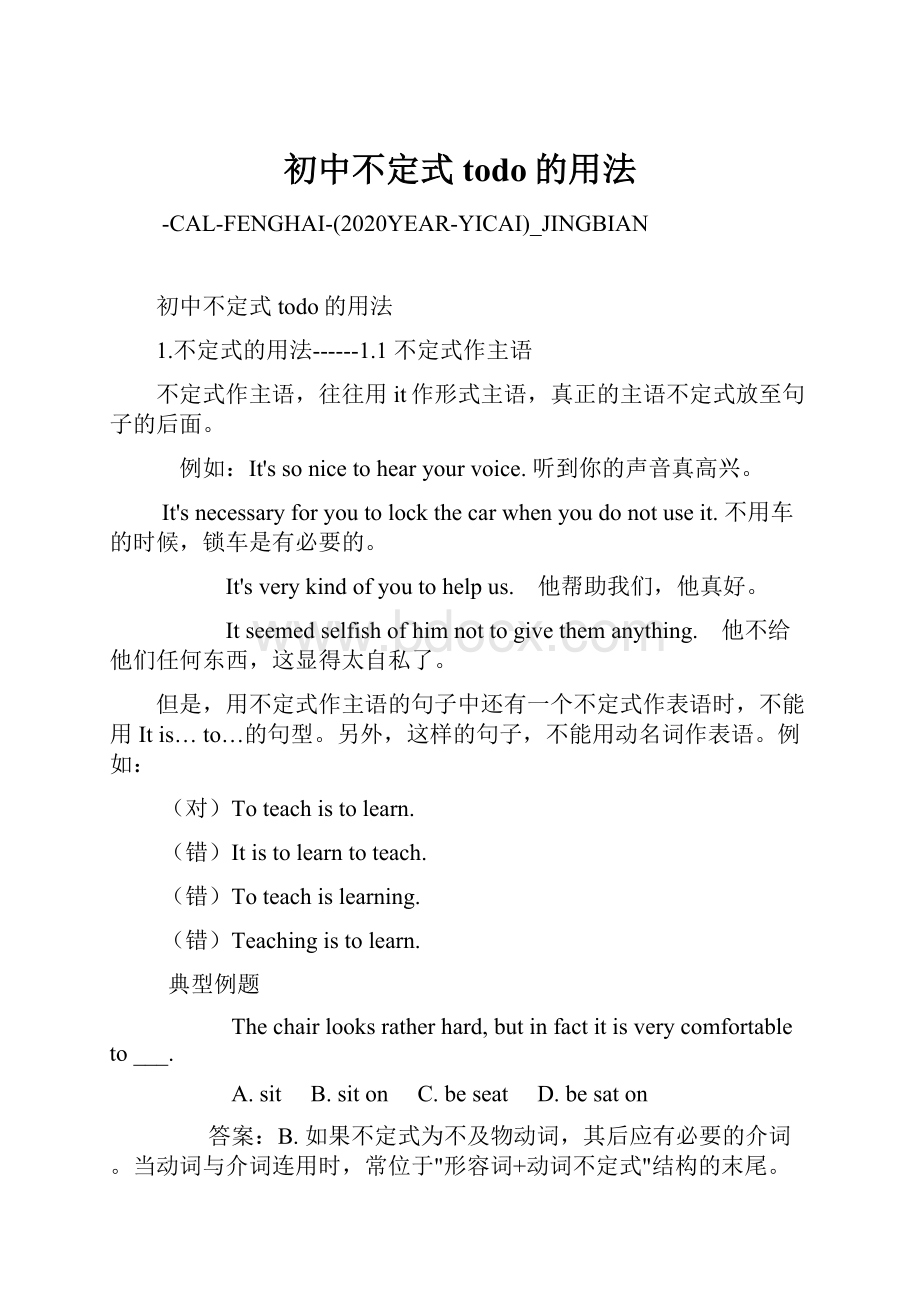 初中不定式todo的用法.docx
初中不定式todo的用法.docx
- 文档编号:8709082
- 上传时间:2023-02-01
- 格式:DOCX
- 页数:11
- 大小:21.90KB
初中不定式todo的用法.docx
《初中不定式todo的用法.docx》由会员分享,可在线阅读,更多相关《初中不定式todo的用法.docx(11页珍藏版)》请在冰豆网上搜索。

初中不定式todo的用法
-CAL-FENGHAI-(2020YEAR-YICAI)_JINGBIAN
初中不定式todo的用法
1.不定式的用法------1.1不定式作主语
不定式作主语,往往用it作形式主语,真正的主语不定式放至句子的后面。
例如:
It'ssonice tohearyourvoice.听到你的声音真高兴。
It'snecessaryforyou tolockthecarwhenyoudonotuseit. 不用车的时候,锁车是有必要的。
It'sverykindofyou tohelpus. 他帮助我们,他真好。
It seemedselfishofhim nottogivethemanything. 他不给他们任何东西,这显得太自私了。
但是,用不定式作主语的句子中还有一个不定式作表语时,不能用Itis…to…的句型。
另外,这样的句子,不能用动名词作表语。
例如:
(对)Toteach is tolearn.
(错)It is tolearntoteach.
(错)Toteach is learning.
(错)Teaching is tolearn.
典型例题
Thechairlooksratherhard,butinfactitisverycomfortableto___.
A.sit B.siton C.beseat D.besaton
答案:
B. 如果不定式为不及物动词,其后应有必要的介词。
当动词与介词连用时,常位于"形容词+动词不定式"结构的末尾。
1.1.1不定式做主语It'sforsb/It'sofsbtodosth
这样的句子中,由于表语形容词性质的不同,导致了不定式逻辑主语标志用for或of的区别。
1)forsb. 句型中的形容词一般为表示事物的特征特点,表示客观形式的形容词,如easy,hard,difficult,interesting,impossible等:
例如:
It'sveryhard forhim tostudytwolanguages.对他来说学两门外语是很难的。
2)ofsb句型中的形容词一般为表示性格,品德,心智能力,表示主观感情或态度的形容词,如good,kind,nice,clever,foolish,right。
例如:
It'sverynice ofyou tohelpme.你来帮助我,你真是太好了。
1.2不定式作宾语
有些及物动词用不定式作宾语,结构为动词+不定式。
例如:
afford
aim
agree
arrange
ask
decide
bother
care
choose
demand
desire
determine
elect
endeavor
hope
fail
help
learn
long渴望
mean
manage
offer
plan
pretend
refuse
tend
undertake
expect
hate
intend
例如:
Thedriver failed tosee theothercarintime.司机没能及时看见另一辆车。
He offered tohelp me.他表示愿意帮助我。
2)有些动词除了可以用不定式作宾语,还用不定式作补语,即有动词+宾语+不定式的结构。
例如:
ask
choose
expect
help
beg
intend
like/love
need
prefer
prepare
want
wish
例如:
I like tokeep everythingtidy. 我喜欢每件东西都保持整洁。
I like youtokeep everythingtidy. 我喜欢你使每件东西都保持整洁。
I want tospeak to Tom. 我想和汤姆谈话。
I want youtospeakto Tom. 我想让你和汤姆谈话。
3)有些动词或动词词组可以用动词+疑问词+不定式的结构作宾语。
例如:
decide
know
consider
forget
learn
remember
show,
wonder
findout
tell
inquire
explain
例如:
Please show us howtodo that.请演示给我们如何去做。
Therearesomanykindsoftape-recordersonsalethatI don't know which tobuy.
有这么多的录音机,我都拿不定主意买哪一种。
1.3不定式作表语
不定式可放在be动词后面,形成表语。
例如:
Mywork is toclean theroomeveryday.我的工作是每天清扫房间。
Hisdream is tobeadoctor.他的梦想是成为一名医生。
1.4不定式作定语
不定式做定语通常要放在被修饰的词后,往往表示未发生的动作。
例如:
Ihavealotofwork todo. 我有许多事要做。
Therewasnothing tobringhome thatmorning.那天早上(他回家时)两手空空。
1.5不定式作状语
1)目的状语
常用结构为todo,onlytodo(仅仅为了), inordertodo, soastodo, so(such)…asto…(如此…以便…)。
例如:
Heran so fast asto catchthefirstbus. 他飞快地跑以便赶上第一班车。
Icomehereonly to saygood-bye to you. 我来仅仅是向你告别。
2)作结果状语,可以表示没有预料到的或事与愿违的结果,不定式要放在句子后面。
Iawoke to findmytruckgone. 我醒来发现箱子不见了。
Hesearchedtheroomonly to findnothing. 他搜索了房间,没发现什么。
3)表原因
I'mglad to seeyou.见到你很高兴。
Shewept to seethesight. 她一看到这情形就哭了。
4)表示理由和条件
Hemustbeafool to sayso.
Youwilldowell to speakmorecarefully.
1.6不定式作补语
1) 有些有动词+宾语+不定式的结构。
例如:
宾语
不定式
Hereminded
me
tobuysomeeggs.
THAT-从句
Hereminded
me
thatIhadtobuysomeeggs.
advise
allow
cause
challenge
command
compel
drive驱使
enable
encourage
forbid
force
impel
induce
instruct
invite
like/love
order
permit
make
let
have
want
get
warn
persuade
request
send
tell
train
urge
例如;
Fatherwillnot allow ustoplay onthestreet. 父亲不让我们在街上玩耍。
Theofficer ordered hismen tofire. 长官命令士兵开火。
注意:
有些动词如make,have,get,want等可用不定式作做宾补,也可用分词作宾补。
现在分词表达主动,也表达正在进行,过去分词表达被动。
2)有些有动词+宾语+不定式的结构,不定式的动词往往是be,不定式一般可以省去。
例如:
consider
find
believe
think
declare(声称)
appoint
guess
fancy(设想)
guess
judge
imagine
know
例如:
We believe him tobeguilty.我们相信他是有罪的。
We know him tobeafool.我们知道他是个笨蛋。
(tobe不能省去)
典型例题
CharlesBabbageisgenerallyconsidered ___thefirstcomputer.
A.toinvent B.inventing C.tohaveinvented D.havinginvented
答案:
C.一般没有consider+宾语+be以外不定式的结构,也没有consider+宾语+doing的结构,排除A、B、D。
consider用动词be以外的不定式作宾补时,一般要求用不定式的完成式,故选C。
3)有些动词可以跟there+tobe的结构。
例如:
believe
expect
intend
like
love
mean
prefer
want
wish
understand
例如:
Wedidn't expect there tobe somanypeoplethere.我们没料到会有那么多人在那里。
Youwouldn’t want there tobe anotherwar.你不至于想让另外一场战争发生吧。
1.7动词不定式的否定式
在不定式标志to前加上not。
例如:
Tellhim notto shutthewindow。
让他别关窗。
Shepretended nottosee mewhenIpassedby.我走过的时候,她假装没看见。
典型例题
1)Mrs.Smithwarnedherdaughter___afterdrinking.
A.nevertodrive B.toneverdriver C.neverdriving D.neverdrive
答案:
A warnsbtodosth. 的否定形式为warnsbnottodosth. 此处用的是否定词never.
2)Theboywantedtoridehisbicycleinthestreet,buthismothertoldhim____.
A.notto B.nottodo C.notdoit D.donotto
答案:
A notto为nottodoit的省略形式。
可以只用to这个词,而不必重复整个不定式词组。
及物动词do后应有宾语,因此也B,D不对。
2.省略不定式符号“to”的情况
1) 情态动词(除ought 外)后。
She can't speak toyou.
He should give hersomemoney.
Shall I talk tohim?
Would you like acupofcoffee?
I might stay anothernightinthehotel.
They must leave before10.00a.m.
2) 使役动词 let,have,make后,感官动词 see,watch,lookat,notice,observe,hear,listento,smell,feel,find 等后。
注意:
被动语态中不能省去to。
例如:
I saw him dance.我看见他跳舞。
=Hewasseentodance.
Theboss made them work thewholenight.老板让他们整夜干活。
=Theyweremadetoworkthewholenight.
He saw her fall fromthecliff.
We heard them close thedoor.
They saw us walk towardthelake.
She felt thespider crawl upherleg.
3)使役动词 let,have,make后
Herparents let her stay outlate.
Let's go tothecinematonight.
You made me love you.
Don't make me study thatboringgrammarbook!
4) wouldrather,hadbetter句型后
We hadbetter take somewarmclothing.
She hadbetter ask himnottocome.
You'dbetter not smile atacrocodile!
We hadbetter reserve aroominthehotel.
You'dbetter give meyouraddress.
They hadbetter work harder ontheirgrammar!
5) Why…/whyno…句型后
6) help 后可带to,也可不带to, helpsb(to)dosth:
7) but和except后。
but前是实义动词do时,后面出现的不定式不带to。
比较:
Hewantstodonothing but go out.他只想出去玩。
Hewantstobelieveanything but totake themedicine.除了吃这药,他什么都信。
8) 由and,or和than连接的两个不定式,第二个to 可以省去:
9) 通常在discover,imagine,suppose,think等词后作宾补时,可以省去tobe。
例如:
Heis supposed (tobe) nice. 他应该是个好人。
典型例题
1)----Iusuallygotherebytrain.
----Whynot___byboatforachange?
A.totrygoing B. tryingtogo C. totryandgo D. trygoing
答案:
D.whynot后面接不带to的不定式,因此选D。
2)Pauldoesn'thavetobemade___.Healwaysworkshard.
A.learn B.tolearn C.learned D.learning
答案:
B.make后接不带to的动词不定式,当其用于被动时,to不可省略。
3.不定式的时态和语态
1) 一般式表示的动词,有时与谓语动词表示的动作同时发生,有时发生在谓语动词的动作之后,例如:
He seems toknow this.他似乎知道这事。
I hope tosee youagain.=IhopethatI'llseeyouagain. 我希望再见到你。
2) 完成式:
完成式表示的动作发生在谓语动词表示的动作之前,比如tohavebroken,tohaveseen,tohavesaved. 例如:
Someonemust havebroken thewindowandclimbedin.
Iwouldlike tohaveseen theTajMahalwhenIwasinIndia.
Hepretended tohaveseen thefilm.
IfI'dseentheballI wouldhavecaught it.
3) 进行式表示动作正在进行,与谓语动词表示的动作同时发生。
例如:
I'dreally like tobeswimming inanicecoolpoolrightnow.
You must bejoking!
I happened tobewaiting forthebuswhentheaccidenthappened.
4) 完成进行式表示动作从过去开始并延续至说话的时候:
(to)havebeen+现在分词 例如:
tohavebeencrying
tohavebeenwaiting
tohavebeenpainting
Thewoman seemed tohavebeencrying.
Youmust havebeenwaiting forhours!
Hepretended tohavebeenpainting allday.
5) 不定式的被动语态:
(to)be+被动式,例如tobegiven,tobeshut,tobeopened 例如:
Iamexpecting tobegiven apay-risenextmonth.
Thesedoorsshould beshut.
Thiswindowought tobeopened.
4.不定式的特殊句型------4.1too…to…
1)too…to 太…以至于…。
例如:
Heis too excited to speak.他太激动了,说不出话来。
----CanIhelpyou需要我帮忙吗
----Well,I'mafraidtheboxis too heavyforyou to carryit,butthankyouallthesame.
不用了。
这箱子太重,恐怕你搬不动,但还是谢谢你。
2)如在too前有否定词,则整个句子用否定词表达肯定,too后那个词表达一种委婉含义,意为"不太"。
例如:
It's never too late to mend. 改过不嫌晚。
(谚语)
3)当too前面有only,all,but时,意思是:
非常…等于very。
例如:
I'm only too pleased to beableto helpyou.能帮助你我非常高兴。
Hewas but too eager to gethome.他非常想回家。
4.2soasto
1) 表示目的;它的否定式是soasnottodo。
例如:
Tomkeptquietabouttheaccident soasnotto losehisjob.汤姆对事故保持沉默是为了不丢掉他的工作。
Goinquietly soasnotto wakethebaby.轻点进去,别惊醒了婴儿。
2) 表示结果。
例如:
Wouldyoube sokindasto tellmethetime
劳驾,现在几点了。
4.3Whynot
"Whynot+动词原形"表达向某人提出建议,翻译为:
"为什么不……""干吗不……"。
例如:
Whynot takeaholiday?
干吗不去度假?
- 配套讲稿:
如PPT文件的首页显示word图标,表示该PPT已包含配套word讲稿。双击word图标可打开word文档。
- 特殊限制:
部分文档作品中含有的国旗、国徽等图片,仅作为作品整体效果示例展示,禁止商用。设计者仅对作品中独创性部分享有著作权。
- 关 键 词:
- 初中 不定式 todo 用法
 冰豆网所有资源均是用户自行上传分享,仅供网友学习交流,未经上传用户书面授权,请勿作他用。
冰豆网所有资源均是用户自行上传分享,仅供网友学习交流,未经上传用户书面授权,请勿作他用。


 1212中级汽车维修工考试试题三.docx
1212中级汽车维修工考试试题三.docx
